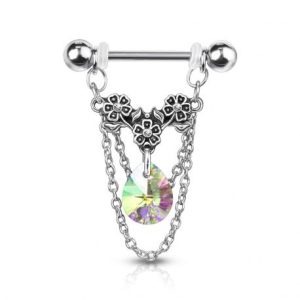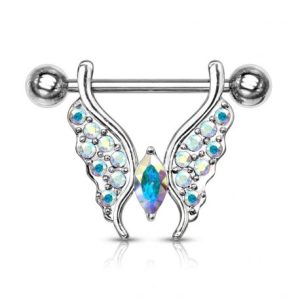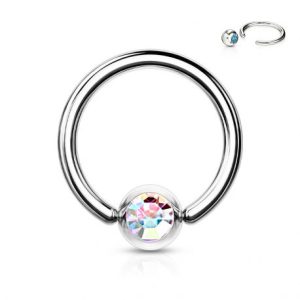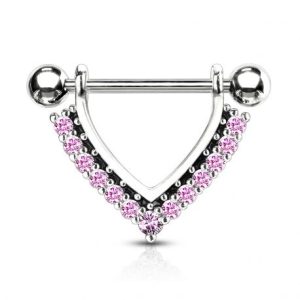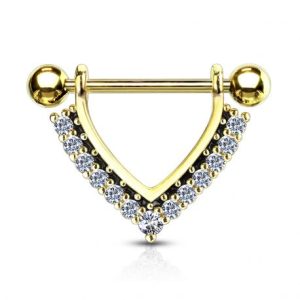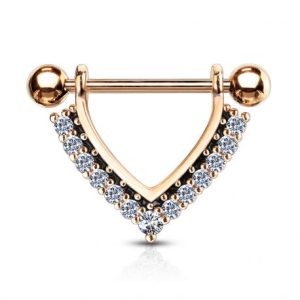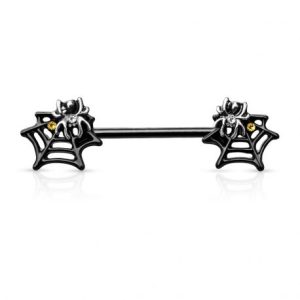Nipple Piercing
Understanding Nipple Piercings: A Complete Guide
Are you intrigued by the idea of nipple piercings but feel overwhelmed by the plethora of information out there? You’re not alone. Nipple piercings can be a unique and personal form of self-expression, but they also come with their own set of challenges and considerations.
From understanding the healing process to choosing the right jewelry and dealing with potential risks, it’s essential to be well-informed before you take the plunge. In this comprehensive guide, we’ll demystify the world of nipple piercings, providing you with the knowledge you need to make an informed decision.
What is Nipple Piercing?
Nipple piercing, a form of body modification cherished by both men and women, is a unique way of self-expression and body adornment. It involves the insertion of a needle through the base of the nipple to create a hole, which is then adorned with jewelry. The piercing can be placed at any angle, be it horizontally, vertically, or even diagonally, offering a high degree of customization to the individual.
The allure of nipple piercings lies not only in their aesthetic appeal but also in their ability to remain concealed. This makes them an ideal choice for those who prefer to keep their body art private due to professional constraints, personal reasons, or family preferences. Despite being hidden, these piercings can provide a sense of completeness and personal satisfaction to the wearer.
Nipple piercings are often seen as an enhancement to the natural beauty of the breasts, irrespective of their size. They add an intriguing element to the wearer’s appearance, often boosting confidence and fostering a positive body image. Many women enjoy the allure of going braless, allowing the subtle hint of their piercings to spark the imagination.
Contrary to popular belief, nipple piercings do not lead to a loss of sensitivity. In fact, many individuals report an increase in sensitivity post-piercing, adding a new dimension of sensation and enjoyment. Additionally, the myth that nipple piercings prevent breastfeeding has been debunked. While it is recommended to remove the jewelry during breastfeeding to avoid potential choking hazards, breastfeeding is still possible with the appropriate precautions.
Healing a nipple piercing requires patience, but the end result is often considered well worth the effort. As a favorite among body art enthusiasts, nipple piercings offer a unique blend of personal satisfaction, aesthetic appeal, and heightened sensitivity. As with any body modification, it’s essential to ensure the procedure is performed by a professional and that proper aftercare is followed to maintain the health and integrity of the piercing.
| Types of Piercing | Placement | Pricing | Pain Level | Healing Time |
|---|---|---|---|---|
| Nipple Piercing | Through the base of the nipple, typically horizontally | $30 – $50 | 6/10 | 6-9 months (up to 1 year) |
Different Types of Nipple Piercings
Nipple piercings come in a variety of styles, each offering a unique aesthetic. The type of piercing you choose can be a personal expression of your style, personality, or even your lifestyle. Here’s a deeper look at the different types of nipple piercings:
-
Horizontal Nipple Piercing
Horizontal piercings are the most common type of nipple piercing. This style involves a straight barbell that passes horizontally through the base of the nipple. The barbell ends can be simple balls or more decorative elements, such as gemstones or other shapes. The horizontal piercing is a classic choice that offers a lot of versatility in terms of jewelry options. It’s also typically the easiest type of nipple piercing to heal, as it aligns naturally with the anatomy of most nipples.
-
Vertical Nipple Piercing
Vertical piercings offer a unique twist on the traditional nipple piercing. Instead of passing through the nipple horizontally, the barbell is inserted vertically. This creates a striking visual effect that can be especially appealing when paired with a ring or circular barbell. Vertical piercings can be a bit more challenging to heal than horizontal ones, as they can be more prone to movement and friction from clothing. However, with proper care and attention, they can be a fantastic option for those seeking a less common type of nipple piercing.
-
Inverted Nipple Piercing
Inverted nipple piercings are a special type of piercing designed for individuals with inverted nipples. Inverted nipples are those that retract inward rather than protruding outward. For these individuals, a nipple piercing can help to create a more protruding appearance. The piercing process for inverted nipples is slightly different and requires a skilled and experienced piercer. The piercer may use a technique called “nipple eversion” to bring the nipple out before piercing it. Once healed, the jewelry helps to maintain the nipple’s protruding appearance.
-
Double Nipple Piercing (Iron Cross)
Double nipple piercings, also known as cross piercings, involve two separate piercings in the same nipple. The most common configuration is one horizontal and one vertical piercing, creating an iron cross or “X” shape. This style of piercing offers a bold, edgy aesthetic.
It’s worth noting that double piercings require more aftercare and healing time than a single piercing. They also require a nipple that’s large enough to accommodate two pieces of jewelry without causing discomfort or complications. As always, a consultation with a professional piercer is essential to determine if this style of piercing is a good fit for your anatomy and lifestyle.
-
Diagonal Nipple Piercings
Diagonal nipple piercings are another unique variation that adds a distinctive touch to your body art. As the name suggests, these piercings are placed diagonally across the nipple. The angle of the piercing can vary based on personal preference and anatomy, but it typically runs from the upper left to the lower right, or vice versa.
The diagonal piercing can be done with a straight barbell, similar to the horizontal and vertical styles. The ends of the barbell can be customized with different designs, colors, and materials to match your personal style.
Voir cette publication sur Instagram
Nipple Piercing Placement and anatomical consideration
Nipple piercings offer a unique blend of personal expression and aesthetic appeal, with a variety of placement options to suit individual preferences. These placements can be horizontal, vertical, or diagonal, and can even involve multiple piercings in different directions for a more creative look. The choice of jewelry can be tailored to fit specific placements, such as curved barbells for horizontal piercings or rings for vertical ones. This versatility allows for a high degree of customization and personalization.
One important consideration when planning a nipple piercing is the individual’s anatomy. Some people have inverted nipples, which are characterized by the nipple appearing to retract inward rather than protruding outward. Interestingly, nipple piercing can often rectify this condition. The process of piercing creates a tube of scar tissue that helps to keep the nipple in an extended position, even if the jewelry is eventually removed after the healing process.
However, piercing inverted nipples requires a certain level of expertise and experience. It’s crucial to do thorough research and find a piercer who is familiar with this specific condition and knows how to use the correct tools. The piercing not only helps to bring the nipple out but also prevents it from retracting again, with the barbell providing the necessary support.
Nipple Piercing Procedure
The nipple piercing procedure is a meticulous process that requires careful preparation, precise execution, and diligent aftercare. Here’s a detailed look at each step:
- Selecting the Right Piercer: The importance of choosing a reputable piercer cannot be overstated. Entrusting your body to a professional ensures that high-quality jewelry is used, which is essential in any piercing procedure. Utilizing low-quality jewelry can lead to severe complications, including infections that could result in unwanted deformations.
- Preparation: The first step in the nipple piercing procedure involves marking the placement of the piercing. It’s crucial to ensure that the nipple is fully erect during this process. This is because the nipple undergoes twisting when it becomes erect, and marking it while in a non-erect state can result in a crooked piercing. All undergarments and clothing above the waist need to be removed for this process. Depending on the preference of your piercer and the furniture in the piercing room, you may be in a position anywhere from seated to reclining flat.
- Piercing: The actual piercing is performed using forceps to hold the nipple and a needle to create the hole. The piercer may perform tissue manipulation prior to the application of the clamps, especially for tight skin or underdeveloped nipples. If the forceps are especially difficult to apply, then more manipulation may be in order. It’s crucial to ensure that the piercer uses gloves and a cork to prevent accidents during the procedure.
- Jewelry Insertion: For fresh nipple piercings, it is recommended to use a straight 14 or 12 gauge barbell. However, individuals with smaller nipples may opt for a smaller size, such as a 16-gauge barbell. The standard jewelry for nipple piercings is typically 14-gauge, with lengths ranging from 5/8 to 3/4. Once the piercing has fully healed, individuals have the freedom to switch to various jewelry options such as rings, clickers, or even nipple shields, according to their personal style and preferences. This flexibility in jewelry selection allows for a customized look that can cater to all nipple sizes and personal aesthetics.
- Simultaneous Piercings: Certain studios provide the option of tandem piercings, where both nipples are pierced at the same time by two coordinated piercers. This approach is particularly beneficial if you intend to have both nipples pierced and are apprehensive about the procedure’s tolerance. To ensure symmetry, one piercer may be responsible for marking the placement on both nipples.
- Sensitivity and Comfort: The sensitivity of nipples varies significantly among individuals. If your nipples are particularly sensitive, it’s crucial to choose a highly skilled technician, as this can greatly influence your comfort during the procedure. It’s recommended to maintain slow, deep breaths throughout the process to help manage anxiety. Rapid, shallow breathing could potentially lead to a panic attack or fainting due to nerves. Even if these extreme reactions don’t occur, such breathing patterns can increase tension, making the piercing experience more unpleasant.
@dimitri.daleno NIPPLE PIERCING – Tu li faresti? 😅😰😱 #piercingstudio #piercingvideo #piercingtok #bodypiercer #bodypiercings #pauraaaaaaaaaaa ♬ suono originale – Dimitri Daleno
Nipple Piercing Pain
Piercing the nipple is often a less painful experience than one might anticipate. Contrary to popular belief, many individuals compare the sensation to a sharp pinch or brief sting, rather than an excruciating pain. It is important to remember that anxiety or fear can sometimes amplify the anticipated discomfort, whereas the actual piercing process is typically swift. On a pain scale, individuals commonly rate the pain level during nipple piercing at around 6 out of 10, with 10 being the highest level of pain.
However, it’s worth noting that pain tolerance varies significantly from person to person. While some individuals report a high level of pain during the piercing, others find it relatively manageable. For instance, some women describe the piercing process as a moment of intense, yet fleeting, discomfort. On the other hand, individuals with a high pain tolerance may find the experience more bearable, although some have reported this particular piercing to be an exception, describing the pain as intolerable.
Post-piercing, the nipples can remain sensitive for several weeks. During this healing period, it’s crucial to avoid any unnecessary contact or friction, which could exacerbate the sensitivity or potentially lead to complications. Wearing a bra can provide some protection for those with larger breasts. Despite the initial discomfort, many find the healing process fairly easy and painless, provided they keep the piercings clean and avoid any undue stress to the area.
Nipple Piercing Healing Process
Nipples are known for their slower healing process, necessitating proper attention and care. Understanding the healing journey is crucial before getting nipple piercings, ensuring you can provide the necessary time and care for optimal results.
-
Healing Time
The healing process for nipple piercings is often more protracted than other types of piercings, typically ranging from four to six months on average. However, it’s not uncommon for this period to extend up to a year or more in some cases. This is due to the fact that nipples are generally slow-healing, requiring a significant amount of time and care to fully recover. Therefore, it’s advisable to get nipple piercings at a time when you’re confident you can provide them with the necessary attention and care.
During this healing period, the nipples can experience heightened sensitivity and swelling. This sensitivity can sometimes be so intense that even a slight brush against them can cause discomfort. To accommodate potential swelling, longer barbells are typically used in the initial stages of healing.
-
Aftercare
The aftercare for nipple piercings is a crucial part of the healing process. Maintaining cleanliness is paramount, not only for the piercing itself but also for any clothing that comes into contact with it, such as bras. Sea salt soaks are often recommended for cleaning the piercing, while harsh products and alcohol-based solutions should be avoided as they can irritate the piercing and prolong the healing process.
Lifestyle adjustments may also be necessary during the healing period. For instance, changes to bras and sleeping habits may be required to avoid discomfort or injury. High-cut t-shirts or sports bras are recommended for sleep, providing protection while preventing the piercing from getting caught.
-
Post-Healing
Even after the piercing has healed, some individuals may still experience occasional tenderness or crusting. This is a normal part of having a nipple piercing and can be managed with regular cleaning. In fact, some individuals have reported that their piercings continue to crust slightly, even years after getting them. This highlights the importance of ongoing care for nipple piercings, regardless of how long you’ve had them.
Nipple Piercing Jewelry
Nipple piercings offer a unique blend of personal expression and privacy. They can be easily concealed, making them an ideal choice for those who may have restrictions due to work, family preferences, or personal reasons. When choosing nipple piercing jewelry, there are several factors to consider, including placement, fit, and visibility.
-
Placement and Fit
The placement of your piercing and the fit of your jewelry can significantly impact your comfort and the healing process. Well-placed piercings with snug-fitted, quality jewelry can enhance the overall experience. It’s also important to remember that nipple sensitivity varies from person to person. If you have tender nipples, it’s crucial to seek an experienced technician to ensure your comfort during the procedure.
-
Visibility
One of the advantages of nipple piercings is their ability to remain hidden. For men, nipple piercings may be discernible under a lightweight white dress shirt, but an undershirt can significantly reduce visibility. For women, anything but the sheerest bra will usually make it difficult to see nipple jewelry through clothing.
The type of jewelry can also affect its visibility. Using a cylinder-shaped bead instead of a round one in your captive ring can eliminate the appearance of a second nipple protruding below your own. Snug-fitting barbells capped by small balls or discs are effective for concealment under clothing in most situations. A captive cylinder or tube can help to diminish the visibility of nipple rings through clothing.
-
Types of nipple piercings jewelry
Nipple piercings offer a unique opportunity for personal expression through a wide variety of jewelry options. Each type of jewelry has its own aesthetic appeal and practical considerations.
Here’s a more detailed look at the most common types of nipple piercing jewelry:
-
Barbells
Barbells are the most common type of nipple piercing jewelry, and for good reason. Their simple design consists of a straight bar with a ball or other decorative element on each end. This straightforward structure makes them easy to insert and remove, and their flat ends can be comfortable against the skin. Barbells are versatile and come in a variety of lengths, thicknesses, and materials, making them suitable for a wide range of personal styles and healing stages.
-
Captive Bead Rings (CBRs)
Captive Bead Rings (CBRs) are circular rings with a small bead that clips into the ring. Their circular design can be visually striking, and the bead adds an extra decorative touch. CBRs can be a great choice for healed nipple piercings, as the bead can be swapped out for different colors or designs. However, their circular shape may make them more prone to catching on clothing, so they may not be the best choice for those with active lifestyles or during the initial healing process.
-
Circular Barbells
Also known as horseshoe barbells, these pieces are similar to straight barbells but are bent into a circular shape. This gives them a unique look that can be a fun alternative to traditional barbells or CBRs. The open ends of the horseshoe shape can make them easier to clean and less likely to catch on clothing, making them a practical choice as well.
-
Nipple Shields
Nipple shields are decorative pieces that encircle the nipple and are held in place by a barbell. They come in various designs, from intricate patterns to simple circles, and can add a dramatic flair to your nipple piercing. However, due to their larger size and more complex design, nipple shields are typically recommended for healed piercings and may not be suitable for everyday wear.
-
Nipple Clickers
Nipple clickers are hinged rings that ‘click’ into place, making them easy to insert and remove. This convenience, combined with their sleek design, makes them a popular choice for many people with nipple piercings. They can be a great option for those who like to change their jewelry frequently or who prefer a more minimalistic look.
-
Nipple Chains
Nipple chains connect two nipple piercings together, creating a bold and stylish look. They can be a striking choice for special occasions, but may not be suitable for everyday wear due to their length and the potential for catching on clothing. It’s also important to note that nipple chains require both nipples to be pierced and healed, so they may not be an option for everyone.
| Type of Jewelry | Description | Pros | Cons |
|---|---|---|---|
| Barbells | Straight bar with a ball or decorative element on each end. | Easy to insert and remove. Comfortable against the skin. Versatile with various lengths, thicknesses, and materials. | None. |
| Captive Bead Rings (CBRs) | Circular rings with a small bead that clips into the ring. | Visually striking. Bead can be swapped out for different colors or designs. | More prone to catching on clothing. May not be suitable for active lifestyles or during the initial healing process. |
| Circular Barbells | Similar to straight barbells but bent into a circular shape. | Unique look. Easier to clean and less likely to catch on clothing. | None. |
| Nipple Shields | Decorative pieces that encircle the nipple, held in place by a barbell. | Adds a dramatic flair to the piercing. Comes in various designs. | Larger size and more complex design. Recommended for healed piercings. May not be suitable for everyday wear. |
| Nipple Clickers | Hinged rings that ‘click’ into place. | Easy to insert and remove. Sleek design. | None. |
| Nipple Chains | Connects two nipple piercings together. | Creates a bold and stylish look. | Requires both nipples to be pierced and healed. May not be suitable for everyday wear due to length and potential for catching on clothing. |
Nipple Piercing Risks and Complications
Nipple piercings, while aesthetically pleasing for many, come with their own set of potential risks and complications. It’s important to be aware of these before deciding to get a nipple piercing.
-
Migration and Rejection
One of the risks associated with nipple piercings is migration and rejection. This occurs when the piercing moves or twists, often due to pressure from clothing or bras, especially in individuals with larger breasts. To mitigate this risk, consider wearing your ring flipped up inside your bra or opt for barbells instead of rings. If you notice any signs of migration, switching to inert plastic jewelry may help halt the progression.
-
Inflammation and Infection
Inflammation and infection are other potential complications. During the initial healing phase, a hardened lump may form behind the nipple or areola, often accompanied by localized swelling. This is not necessarily a sign of infection, but if the lump persists for more than two weeks, it’s advisable to consult a doctor. Infections can be treated by cleaning the area, applying a warm compress or sea salt soak, and avoiding harsh products. One individual suggested using the shot glass method, removing the jewelry and boiling it, then reinserting it after it has cooled down.
-
Clothing and Daily Activities
Another aspect to consider is the impact of daily activities and clothing on the piercing. Rough fabrics, lacy bras, or shirts can get caught on the jewelry, causing discomfort or irritation. Accidental scratching or knocking can also cause pain. Therefore, it’s important to always be mindful of the piercing and take precautions to avoid these issues.
-
Piercing Techniques
The technique used to pierce the nipple can also lead to complications. Piercing too deep, where the needle goes through the areola instead of the nipple, can cause issues such as inadequate bar length, increased risks, and additional problems. Therefore, it’s crucial to choose a knowledgeable and skilled piercer to avoid such complications.
-
Long-Term Risks
Lastly, nipple piercings can potentially grow out, similar to surface piercings. This occurs when the jewelry starts to migrate or move out of the nipple, and the barbell may become visible. It’s important to keep in mind that these risks and complications can occur at any time as long as you have the piercing. Therefore, proper care and regular check-ups with your piercer are essential to maintain the health of your piercing.
Changing and Retiring Nipple Piercing
Changing or retiring a nipple piercing is a process that requires careful consideration and attention to detail. It’s important to remember that the skin around a nipple piercing can be quite sensitive, and rushing the process or handling the jewelry improperly can lead to discomfort or even complications.
-
Changing piercing
Once your piercing has fully healed, you may feel comfortable changing the jewelry on your own. However, this task can be challenging due to the tightness of the skin around the piercing.
If you decide to change your jewelry on your own, it’s important to remember that nipple piercings tend to close very quickly. Therefore, you should immediately insert your new jewelry after removing the old one to prevent the piercing from closing.
To make the process easier, consider soaking the area in warm water or applying a compress to loosen the tissue. Using a sterile lubricant, such as jelly or emu oil, can also facilitate the process. If you encounter any difficulties, an insertion taper can also be used to open the channel and stretch the piercing enough to reinsert the jewelry.
Changing your nipple jewelry can be a bit tricky, especially for the first time. If you’re unsure or uncomfortable doing it yourself, it’s recommended to seek the assistance of a professional piercer. They have the necessary experience and tools to change your jewelry safely and efficiently.
-
Removing piercing
Retiring a nipple piercing, on the other hand, is a decision that should not be made impulsively. The piercing can leave permanent modifications to the area, including tissue development and potential divots at the entry and exit points. If you decide to abandon the piercing, much or all of this tissue development may remain. Therefore, it’s important to think carefully before removing your nipple jewelry, as many individuals regret this decision and find it much easier to keep an existing piercing than to undergo a reinsertion or repiercing later.
Nipple Piercing: Impact on Breastfeeding
Nipple piercings and breastfeeding can coexist, but it’s crucial to consider timing, healing, and potential risks. It’s not advisable to get a new piercing while pregnant due to potential risks to the baby, such as infection or allergic reactions. If you’re planning to become pregnant, it’s best to postpone piercings with extended healing times.
Here’s a more detailed look at the potential issues and considerations:
- Milk Flow: Nipple piercings do not typically affect the milk ducts, as there are multiple ducts and the piercing is unlikely to damage all of them. However, scar tissue from the piercing can potentially interfere with milk flow. This is not typically a problem for most people, but it can be a concern for some.
- Jewelry: The jewelry used in nipple piercings can pose a risk to the baby. There’s a potential choking hazard if the jewelry becomes loose. Additionally, the jewelry can cause damage to the baby’s mouth or interfere with the baby’s ability to latch onto the nipple properly. For these reasons, it’s generally recommended to remove the jewelry during breastfeeding.
- Infection: Any piercing can potentially become infected, and an infected nipple piercing can pose a risk to the baby. It’s important to keep the piercing clean and to monitor it closely for signs of infection, especially during the healing process.
- Sensitivity: Some people find that their nipples are more sensitive or even painful after getting a piercing. This can potentially make breastfeeding more uncomfortable. However, sensitivity varies widely from person to person, and many people do not experience any increased discomfort while breastfeeding.
- Healing Time: Nipple piercings can take a long time to heal (up to a year in some cases), and it’s generally not recommended to remove the jewelry during this time as the piercing can quickly close up. If you’re planning on getting pregnant and breastfeeding, it’s important to consider the timing of the piercing.
Most healed piercings, except for those on the navel, nipples, or genitals, do not experience significant issues during pregnancy. However, hormonal fluctuations can affect even old piercings.
Nipple Piercing Pros & Cons
The decision to get a nipple piercing comes with its own set of advantages and disadvantages, which can vary greatly depending on individual experiences and personal preferences.
Pros
- Many find that nipple piercings make their nipples appear more attractive, whether they are erect or not. This can lead to increased body confidence, especially when naked.
- The piercing can serve as a fun, sexy secret to share with potential partners, adding an element of surprise and intrigue to intimate encounters.
- The act of getting a nipple piercing can be a personal statement of confidence and sexiness, contributing to a sense of empowerment and individuality.
- As a hidden piercing, it can be easily concealed, making it a personal choice whether to reveal it or not.
Cons
- Nipple piercings can take several months to heal, during which time they can be prone to infection and discomfort.
- The healing process may require changes to sleeping habits and sexual activities. For instance, oral contact with the piercing is not recommended for at least 4-6 months due to the risk of infection.
- The piercing process can be quite painful, and some people may experience discomfort during the healing process. Even after healing, the piercings may still crust slightly.
- If the jewelry is removed for a significant period, the piercing may close up, requiring a re-piercing if you wish to maintain it.

